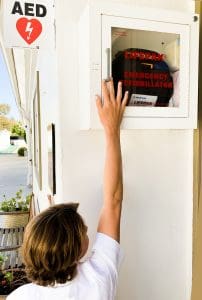An emerging threat to many organizations is “failure to rescue” children and adults experiencing sudden cardiac arrest or harm due to major trauma, such as active shooter events. The standard of care for these medical emergencies is rapidly evolving, and leaders need to act now to keep up or pay the price of harm to their constituents and the growing liability exposures that often accompany these types of medical emergencies.
The good news is that if a person experiencing cardiac arrest can be resuscitated with an automated external defibrillator (AED) within three minutes, he or she has a much better chance of surviving. If a gunshot victim can be provided treatment to stop their severe bleeding within three minutes, their chances of survival greatly increase as well.
Organizations should have AEDs and bleeding control gear together in the same location and one minute away from any victim to win the fight against failure to rescue. Bystanders must beat the clock.
These measures are becoming the bystander care goals of leading organizations that are closing the gap between when a victim’s organs start to die without oxygen at four minutes after the onset of a medical emergency and the average response time of professional first responders, which is 10 minutes. At three minutes, we begin counting lives saved or lives lost; our response is key.
However, the majority of lawsuits following out-of-hospital cardiac arrests and deadly force incidents revolve around organizations failing to have accessible emergency supplies and staff properly trained to use them. (There are almost no lawsuits alleging improper bystander care or misuse of emergency supplies or AEDs.)
Here’s how your campus can address this emerging threat.
AED Accessibility a Significant Challenge
Almost 1,000 out-of-hospital sudden cardiac arrests occur every day with 7,000 occurring every year in children and youth — one-quarter happen on the playing field. When we look through the lens of those we serve, we now have some good metrics for getting the right care at the right time…every time.
There is clear consensus that the most effective way to improve the survival rate of cardiac arrest victims is to strengthen the early links of the survival chain with bystander cardiopulmonary resuscitation and Public Access to Defibrillation (PAD). However, when most organizations review whether they can get CPR care and AEDs to sudden cardiac arrest victims within three minutes 24/7/365, most organizations come up short. Multiple studies show there may be only a one-in-five chance of an AED being near enough to a victim.
Not only are there not enough AEDs located close enough to victims in public places, but those that are nearby are inaccessible more than 50% of the time. They are either in buildings that are locked at night or there are barriers to access them. AEDs also are often without clearly visible signage or are positioned out of reach at schools so those of small stature may not be able to retrieve them in an emergency.

Often, AEDs are placed so they can’t be reached by shorter individuals.
There are other issues as well. Good Samaritans may fear liability, be confused regarding how to perform CPR while under stress and might not be familiar with how an AED works. Additionally, a recent study found that women are 27% less likely to receive CPR because males are reluctant for fear of sexual harassment allegations when they touch their chest during CPR. They also fear hurting females with vigorous compressions, which underscores the need for training.
Trauma First Aid Gear Saves Lives
The Stop the Bleed Campaign was developed after 20 first graders and six educators were killed at Sandy Hook Elementary School in 2012. As of September 2019, more than one million people have been trained in bleeding control. Now often called “the new CPR,” it educates bystander laypersons in the use of direct pressure, wound packing and tourniquet use for bleeding.
We believe that the standard of care to mitigate harm from active shooter and major trauma events is the adoption of the Stop the Bleed Campaign methods. This in turn drives the need for placement of major bleeding control supplies at multiple locations. Given that gunshot wound victims can bleed out in five minutes or less, the “3 minutes from shot to stop the bleeding” metric makes sense and speaks to the issue of co-locating AED and resuscitation gear with major bleeding control supplies.
Dr. Peter Antevy, who was interviewed by 60 Minutes regarding the Parkland High School mass casualty event, shared that although 34 people were shot and 17 were killed, “17 kids are alive today because of the quick action and quick work of those folks who put on tourniquets and chest seals.”
Stop the Bleed methods can also be applied to other types of medical emergencies stemming from other types of incidents, such as stabbings, car crashes and other accidents.
The Solution – Leadership, Practice and Technology Systems
We can reduce vulnerability to threats with prevention, preparedness, protection and performance improvement. Such an approach can be organized by leadership systems, practice systems and technology systems.
Leadership Systems: When working with leaders, we like to use our 4 A Checklist:
- Aware: We need to make them aware of the performance gaps we are trying to close, as well as the liabilities and fully-loaded cost of inaction.
- Accountable: We want them to determine who must be personally accountable for the work done to close the gap.
- Ability: We define ability as know-how as well as resource allocation, both cash and capacity or worktime (the compensated staff time). Leaders control budgets and new out-of-budget spending.
- Actions: These are the line-of-sight activities that, in aggregate, will produce the stated goals. The leaders within an organization need to understand why regulatory-compliant AEDs and appropriate major bleeding control resources need to be purchased and placed so that a bystander or staff member can get to any victim and begin care within three minutes.
Our job as safety and security leaders is to get other leaders onboard to drive these “4 A’s.”
Practice Systems: Here, concepts, tools and resources are critical to understanding and becoming competent in the best practices of CPR/AED use and the Stop the Bleed skills and methods.
The first best practice is to undertake an organization-wide assessment to determine the response time performance gap that must be closed. The actions include determining the location and concentration of the populations you serve and those who serve them (your staff) 24 hours a day, 365 days a year. You must determine where gear needs to be located so that someone walking briskly at four miles per hour can get from a victim to the gear, retrieve it and initiate care within three minutes. Our approach is to place the gear one minute away from anywhere on the property. Factor in 30 seconds to assess the victim, two minutes to retrieve the gear and 30 seconds to put the gear to action. Assess location, positioning, visibility and accessibility of the gear. You must consider surge events, such as graduation assemblies where you may need to move portable and mobile AEDs to meet the three minutes-to-care test.
Proper CPR/AED and first aid courses need to be taken from the American Heart Association, American Red Cross or other equivalent training organizations. The Stop the Bleed programs are operating in most communities and the courses are free. Our Med Tac Bystander Care Program, which incorporates both certifications in addition to covering other leading causes of preventable death, can be reviewed here, as well as on YouTube.
Best practices can be organized into prevention (primary prevention means to prevent an event from ever happening and secondary prevention means prevention of harm if an event does happen), preparedness (in case of an event), protection (when an event occurs) and performance improvement (learning from other events to improve all the other activities).
Technology Systems: We define “technology” as the products, services and information technologies that will support our best practices and performance improvement. AEDs need to be assessed for regulatory compliance and be using the latest approved algorithms. Make sure you are following the manufacturers’ guidelines for inspections and readiness, battery replacement and recalls.
Ask the following questions:
- Are you following the evolving state regulatory statutes and guidelines?
- Do you have the proper protocols for reporting when an AED is used?
- Have you looked at the new product features of WiFi-enabled readiness-check systems and CPR coaching features, such as metronome commands for frequency of chest compressions?
- Do you have AEDs that are the best device for your operating environment, which might have unique weather or moisture issues? (For example, we place AEDs and bleeding control kits in waterproof cases for our Adopt a Cove program in Southern California).
- Have you considered outsourcing the management of your AED inspections and services that will provide loaner AEDs if yours are used or damaged?
As for trauma and bleeding control supplies, the same issues of fixed, portable and mobile deployment of this gear should be addressed. Ideally, AEDs and trauma gear should be together in the same location.
Once you have mapped the concentration of those you serve and those who serve over time, you must decide how much gear you might put in theaters and assembly halls. The good news is that trauma gear has a considerably longer shelf life and maintenance requires little extra effort if the gear is in the right location and accessible.
Make Your Upgrades Now
The emerging threat of lagging behind the rapidly evolving standard of care for training and technology is one you can tackle now. There is no better time to do it.
Dr. Charles Denham II is the chairman of the Texas Medical Institute of Technology; William Adcox is the chief security officer for the UT MD Anderson Cancer Center and UT-Health Chief of Police; ; Charles Denham III is a Junior Med Tac instructor; Dr.Gregory Botz is a professor of anesthesiology and critical care and UT MD Anderson Cancer Center
This article was originally published in 2019, and the issues mentioned still apply today.







